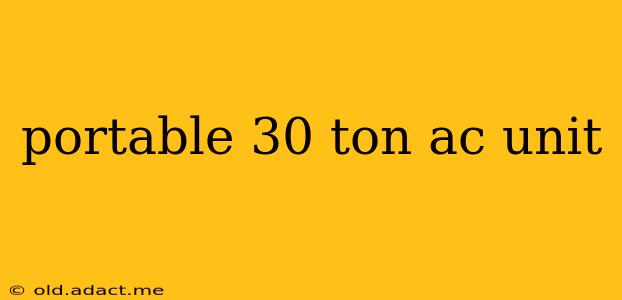Finding a portable 30-ton AC unit presents a unique challenge. While smaller portable AC units are readily available for residential use, systems of this capacity are typically not designed for portability. The sheer size, weight, and power requirements of a 30-ton unit necessitate a different approach than what's typically associated with "portable" air conditioning. This article will explore the options, considerations, and alternatives for achieving 30-ton cooling in a mobile or easily relocatable setup.
What Does a "Portable" 30-Ton AC Unit Even Mean?
The term "portable" for a 30-ton AC unit requires careful definition. Truly portable, as in easily moved by a single person or small team, is practically impossible at this scale. We're talking about industrial-grade equipment weighing many tons and demanding significant power infrastructure. Instead, "portable" in this context might refer to:
- Relocatable units: These are large AC units designed for transport via truck or trailer, suitable for temporary installations at different locations. They're not easily moved, but they are more mobile than permanently installed systems.
- Modular systems: Multiple smaller, potentially more portable units combined to reach the 30-ton capacity. This increases flexibility but requires careful planning for installation and power distribution.
- Containerized units: The entire AC system is housed in a shipping container, offering both protection and ease of transport. This approach is common for temporary or emergency cooling needs.
What are the Alternatives to a Traditional "Portable" 30-Ton AC Unit?
Given the logistical hurdles of moving a 30-ton unit, several alternatives warrant consideration:
- Permanent Installation: For locations requiring consistent 30-ton cooling, a permanently installed system is often the most practical and cost-effective solution in the long run.
- Centralized Cooling Systems: These large-scale systems are common in industrial settings and can be designed to meet specific cooling needs.
What are the Power Requirements for a 30-Ton AC Unit?
This is a crucial consideration. A 30-ton AC unit demands a substantial power supply. You'll need to consult with an electrician to ensure your location can handle the load, likely involving specialized electrical infrastructure and possibly a dedicated transformer. This also impacts the feasibility of truly "portable" options.
How Much Does a 30-Ton AC Unit Cost?
The price of a 30-ton AC unit, even a relocatable one, is considerable. The cost will vary significantly depending on the brand, features, and specific design. You'll need to obtain quotes from several HVAC contractors to get an accurate estimate, factoring in installation, transportation, and any necessary electrical upgrades.
What are the Maintenance Requirements for a 30-Ton AC Unit?
Larger AC units require regular maintenance to ensure optimal performance and longevity. This includes filter changes, refrigerant checks, and potentially more involved servicing. Plan for professional maintenance contracts to minimize downtime and prolong the system's lifespan.
What are the Different Types of 30-Ton AC Units Available?
While the exact specifications vary by manufacturer, the fundamental types would include:
- Air-cooled chillers: These units use air to dissipate heat.
- Water-cooled chillers: These units use water for heat dissipation, often more efficient but requiring a water source and cooling tower.
This article explores the complexities of obtaining a “portable” 30-ton AC unit. While a truly portable option in the traditional sense is unlikely, solutions such as relocatable, modular, or containerized units offer greater mobility than permanently installed systems. Remember to consult with HVAC professionals to determine the optimal solution for your specific needs and location. They can assess your cooling requirements, recommend suitable equipment, and manage the installation and maintenance.
